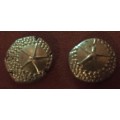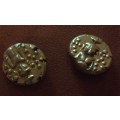

1740 - 1807 GOLD FULL PAGODA - STAR EDITION (BRITISH EAST INDIA COMPANY) RARE STAR EDITION - 2 AVAIL
Check my rate
| Main centres: | 1-3 business days |
| Regional areas: | 3-4 business days |
| Remote areas: | 3-5 business days |
Product information
YOU ARE BUYING A RARE
INDIAN DYNASTY - 1740-1807 GOLD PAGODA - FULL PAGODA STAR EDITION !
VERY VERY RARE IN THE STAR EDITION - NO 2 COINS WEIGH THE SAME OR LOOK THE SAME !
GRAB A BARGAIN OF A LIFETIME TO COMPLETE THAT COLLECTION
WEIGHT 3.35 TO 3.4 GRAMS 80% GOLD - EXACT WEIGHT IS 3.375 & 3.385 GRAMS
The East India Company was formed in the year 1600 and was given a royal charter granting them a British monopoly on trade with the Indies. The company soon began sending ships to India and Java. Initially, the Java trade was the most profitable, but this was displaced soon by the India trade. The company's first factory or trading post was established in 1611 in Masulipatam on the southeastern coast. In 1639, the company received a grant of a lease of Madras from the king of Chandragiri. There they built Fort St. George and Madras replaced Masulipatam as the company's principal settlement on the Coromandel coast.
At the time that the company received the grant of Madras, they also received a grant to mint coins at a price of paying the Chandragiri Raja one and a half per cent as a royalty. The first British coins made in India were gold pagodas, made to resemble the coins of the Vijayanagar kings, who were the Chandragiri Raja's suzerains.
Pagoda was a unit of currency, a coin made of gold or half gold minted by Indian dynasties as well as the British, the French and the Dutch. It was issued by various dynasties in medieval southern India, including the Kadambas of Hangal, the Kadambas of Goa, and the Vijaynagar Empire. There were two types of pagodas coined by foreign traders. The most valuable and dominant gold issue of the early Madras Presidency was the Gold Star pagoda, worth approximately 8 shillings, issued by the East India Company at Madras.
The earliest British coins in Madras showed a single standing figure on the coin, called the "single swami" pagoda; the so-called "3-swami" pagodas were introduced in 1691. Of these, the early type shows the figures full length, on a more compact flan relative to the later type. The Full length 3-swami pagoda shows on the obverse the figure of Lord Venkateswara (principle deity in South India) standing facing, flanked by his two consorts, Sridevi and Bhudevi with a granulated field on the reverse. The later type shows the 3-swami figures standing only three quarters of a length.
The Diameter for these pagoda coins is about 12 - 14 mms, weight about 3.35 grams and they were issued by the British East India Company (E.I.C.) between 1740 and 1807.
In 1807 new machinery was introduced and mint produced 2 silver coin in European style with oblique milling. One series based on Hindu standard consisted of One and Two pagoda in gold, Half and Quarter pagoda and Fanams in silver. The Obv of the pagoda coins had value in English and Persian on ribbon around Gopuram (temple) design while the Rev had value in the local vernacular script, Tamil and Telugu. The copper coins consisted on Cash denominations. The other series based on moghul standard were gold mohurs and fractions of mohurs : ¼, ¿ and ½ . They issued rupees together with fractions down to ¿ and 1⁄16 rupee in silver.
After 1818, Rupee was made the standard coin and the weight was fixed at 180 grains with smaller pieces in proportion. The pagodas and fanams were demonetized from that year. In 1835, the East India Company unified all the coinage under the Coinage Act and the new coins minted in 1835 had the effigy of William IV on the obverse and the value on the reverse in English and Persian. The coins issued after 1840 bore the portrait of Queen Victoria. Following the First War of Independence in 1857, from 1862 to 1947 coins were stuck under the authority of the crown. The first coinage under the crown was issued in 1862 and in 1877 Queen Victoria assumed the title of the Empress of India.

